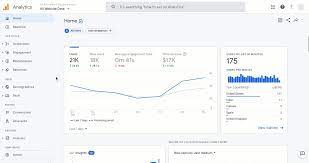
Unleashing the Power of Analytics: A Guide to Data-Driven Decision Making
The Power of Analytics in Modern Business
In today’s fast-paced digital world, data is king. Businesses across all industries are leveraging the power of analytics to gain valuable insights into their operations, customers, and market trends. Analytics has become an indispensable tool for making informed decisions and driving business growth.
Understanding Analytics
Analytics involves the discovery, interpretation, and communication of meaningful patterns in data. By analysing data sets, businesses can uncover trends, correlations, and hidden insights that can guide strategic decision-making.
The Benefits of Analytics
Data-Driven Decision Making: Analytics enables businesses to make decisions based on evidence rather than intuition. By analysing data, businesses can identify opportunities for growth and optimisation.
Improved Operational Efficiency: By tracking key performance indicators (KPIs) through analytics, businesses can streamline processes, reduce costs, and improve overall efficiency.
Enhanced Customer Insights: Analytics allows businesses to understand customer behaviour, preferences, and needs better. This insight enables targeted marketing campaigns and personalised customer experiences.
Types of Analytics
Descriptive Analytics: Descriptive analytics focuses on summarising historical data to understand past performance and trends.
Predictive Analytics: Predictive analytics uses statistical algorithms and machine learning techniques to forecast future outcomes based on historical data.
Prescriptive Analytics: Prescriptive analytics goes a step further by recommending actions to achieve desired outcomes based on predictive models.
The Future of Analytics
The field of analytics is constantly evolving with advancements in technology such as artificial intelligence (AI) and big data processing capabilities. As businesses continue to generate vast amounts of data, the ability to extract actionable insights from this data will be crucial for staying competitive in the digital age.
Understanding Analytics: Key Questions Explored
- What is analytics and how it works?
- Why do we study analytics?
- What are the uses of analytics?
- What are examples of analytics?
- Why is analytics used?
- What do you mean by analytics?
- What does it mean to use analytics?
What is analytics and how it works?
Analytics is the process of analysing data to uncover meaningful insights that can inform decision-making and drive business growth. It involves the use of statistical techniques, algorithms, and tools to interpret data sets and identify patterns, trends, and correlations. Analytics works by collecting relevant data from various sources, transforming it into a usable format, and then applying analytical methods to extract valuable insights. By understanding what analytics is and how it works, businesses can leverage data-driven strategies to improve operational efficiency, enhance customer experiences, and gain a competitive edge in today’s dynamic marketplace.
Why do we study analytics?
Studying analytics is essential in today’s data-driven business landscape as it equips individuals with the knowledge and skills to interpret and utilise data effectively. By understanding analytics, individuals can make informed decisions based on evidence rather than assumptions, leading to improved operational efficiency, strategic planning, and better overall performance. Analytics helps uncover valuable insights hidden within data sets, enabling businesses to identify trends, opportunities for growth, and areas for optimisation. Ultimately, studying analytics empowers individuals to harness the power of data to drive success and innovation in various fields.
What are the uses of analytics?
Analytics plays a pivotal role in modern business operations by offering a multitude of uses and benefits. One of the primary functions of analytics is to provide valuable insights into various aspects of a business, including customer behaviour, market trends, and operational efficiency. By utilising analytics, businesses can make data-driven decisions, improve their processes, enhance customer experiences, and drive strategic growth initiatives. Ultimately, the uses of analytics are vast and versatile, empowering organisations to harness the power of data to achieve their goals and stay ahead in today’s competitive landscape.
What are examples of analytics?
Analytics encompasses a wide range of techniques and tools that businesses use to interpret data and derive valuable insights. Some common examples of analytics include descriptive analytics, which summarises historical data to identify trends; predictive analytics, which uses statistical models to forecast future outcomes based on past data; and prescriptive analytics, which recommends specific actions to achieve desired results. Other examples include customer analytics, social media analytics, web analytics, and business intelligence analytics. Each type of analytics serves a unique purpose in helping businesses make informed decisions and drive growth.
Why is analytics used?
Analytics is used for a multitude of reasons in modern business practices. By harnessing the power of data analysis, analytics enables organisations to uncover valuable insights, trends, and patterns within their data. These insights play a crucial role in informing strategic decision-making processes, identifying opportunities for growth and optimisation, improving operational efficiency, enhancing customer experiences through targeted marketing campaigns, and ultimately driving business success. In essence, analytics empowers businesses to make informed decisions based on evidence rather than intuition, leading to more effective and efficient operations in today’s data-driven world.
What do you mean by analytics?
Analytics refers to the process of analysing data to uncover meaningful insights, trends, and patterns that can inform decision-making and drive business growth. In a business context, analytics involves examining data sets to understand past performance, predict future outcomes, and prescribe actions for optimal results. By leveraging analytics, organisations can gain a deeper understanding of their operations, customers, and market dynamics, ultimately enabling them to make informed decisions that lead to improved efficiency, enhanced customer experiences, and strategic advantages in a competitive landscape.
What does it mean to use analytics?
Using analytics involves the systematic analysis of data to uncover valuable insights and patterns that can inform decision-making and drive business strategies. By utilising various analytical tools and techniques, businesses can gain a deeper understanding of their operations, customers, and market trends. Analytics enables organisations to track key performance indicators, identify opportunities for improvement, and make data-driven decisions that lead to enhanced efficiency, better customer engagement, and ultimately, business growth.

